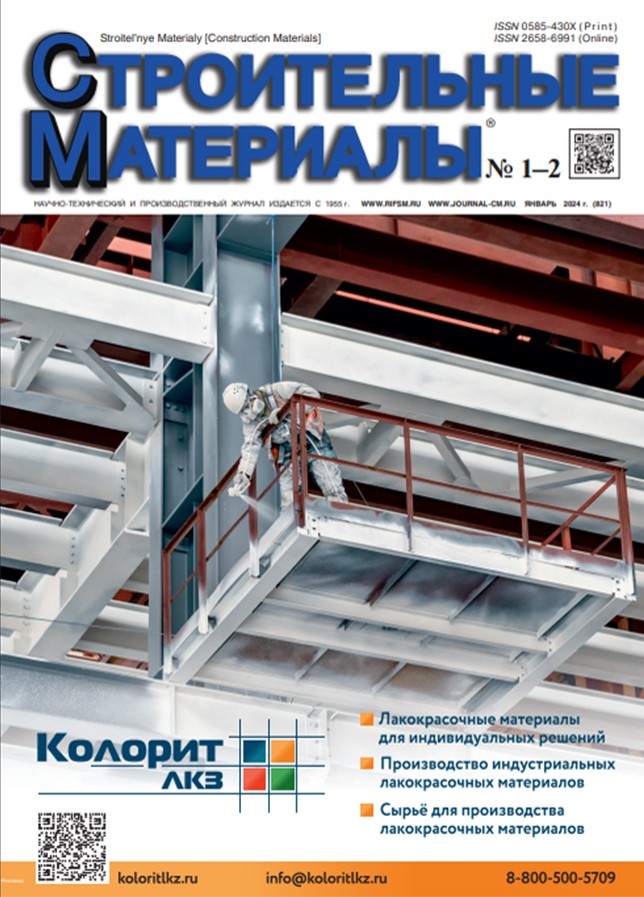Механика долговечности конструкционного бетона: новый подход к явлению деградации. Часть 1. Усадка
- Авторы: Леонович С.Н.1,2
-
Учреждения:
- Белорусский национальный технический университет
- Технологический университет Циндао
- Выпуск: № 1-2 (2024)
- Страницы: 74-78
- Раздел: Современные бетоны
- URL: https://cardiosomatics.orscience.ru/0585-430X/article/view/635972
- DOI: https://doi.org/10.31659/0585-430X-2024-821-1-2-74-78
- ID: 635972
Цитировать
Полный текст
Аннотация
Бетон является материалом, широко используемым в строительных работах и зданиях. Работоспособность бетонных конструкций может поддерживаться в течение длительного времени, если такие конструкции надлежащим образом спроектированы и построены. В статье предложен новый подход к механике долговечности для установления систематического прогнозирования и оценки поведения железобетонных конструкций в зависимости от времени. Химиомеханический износ цементных материалов с течением времени вследствие химических реакций, действия окружающей среды и внешних нагрузок описывается физико-химическими моделями реакции, переноса, разрушения и их соединения. Кроме того, обсуждается долговечность бетонных конструкций. Представлены контуры нескольких репрезентативных исследовательских проектов по механике долговечности.
Ключевые слова
Полный текст
Об авторах
С. Н. Леонович
Белорусский национальный технический университет; Технологический университет Циндао
Автор, ответственный за переписку.
Email: leonovichsn@tut.by
д-р техн. наук, профессор, иностранный академик РААСН
Белоруссия, Минск; ЦиндаоСписок литературы
- Москвин В.М., Иванов Ф.М., Алексеев С.И., Гузеев Е.А. Коррозия бетона и железобетона, методы их защиты. М.: Стройиздат, 1980. 536 с.
- Алексеев С.Н., Иванов Ф.М., Модры С., Шиссль П. Долговечность железобетона в агрессивных средах. М.: Стройиздат, 1990. 320 с.
- Choate P., Walter S. America in ruins: Beyond the public works pork barrel. Council of State Planning Agencies, 1981. 97 p.
- Шалый Е.Е., Леонович С.Н., Ким Л.В. Деградация железобетонных конструкций морских сооружений от совместного воздействия карбонизации и хлоридной агрессии // Строительные матери- алы. 2019. № 5. С. 67–72. DOI: https://doi.org/10.31659/0585-430X-2019-770-5-67-72
- Морозов Н.М., Морозова Н.Н. Исследование долговечности модифицированных бетонов для монолитного строительства // Известия Казанско- го государственного архитектурно-строительного университета. 2012. № 4 (22). С. 312–318.
- Гришина А.Н., Королев Е.В., Михеев А.В., Гладких В.А. Влажностные деформации бетона, подверженного щелочной коррозии. Эксперимен- тальные результаты // Вестник гражданских инженеров. 2020. № 6 (83). С. 140–148.
- Ulm F.J., Bazant Z.P., Wittmann F.H. Creep, shrinkage and durability mechanics of concrete and other quasi-brittle mateluals. Proceedings of the Sixth International Conference CONCREEP-6@MIT. 20–22 August 2001, Cambridge (MA), USA. 809 p.
- Powers T.K. Mechanisms of shrinkage and reversible creep in hardening cement paste. The Structure of concrete and its behaviour under load: Proceedings of an international conference. London. 1965, pp. 319–344.
- Kondo R., Ueda S. Kinetics and mechanism of cement hydration. Proceedings of the Fifth International Symposium on the Chemistry of Cement. Admixtures and special cements. Tokyo. 1968, pp. 203–248.
- Tomosawa F. Cement hydration model, proceedings of the cement technology annual meeting. Cement Association of Japan. 1974. Vol. 28, pp. 53–57.
- Maruyama I., Matsushita T., Noguchi T. Numerical simulation of Portland cement hydration based on particle kinetic model and multicomponent concept. 2008.
- Bjφntegaard Ø., Sellevold, E.J. Interaction between thermal expansion and autogenous deformation in high performance concretes. Materials and structures. 2001. Vol. 34. Iss. 5, pp. 266–272. doi: 10.1007/BF02482205
- Benz D., Kenard D.A., Barogel-Buni V., Garboci E.D., Jennings H.M. Simulation of shrinkage drying of cement paste and mortar: Part 1. Structural models from nanometers to millimeters. Materials and structure.1995. Vol. 28, pp. 450–458. doi: 10.1007/BF02473164
- Koenders E.A.B., van Breugel K. Numerical simulation of autogenous shrinkage of cement paste. Cement and Concrete Research. 1997. Vol. 27. Iss. 10, pp. 1489–1499. https://doi.org/10.1016/S0008-8846(97)00170-1
- Asamoto S., Ishida T., Maekawa K. Time-dependent constitutive model of concrete hardening based on the thermodynamic state of moisture in fine pores. Journal of Advanced Concrete Technology. 2006. Vol. 4(2), pp. 301–323. doi: 10.3151/jact.4.301
- Srisoros W., Nakamura H., Kunieda M., Ishikawa Y. Analysis of crack propagation due to thermal stress in concrete considering solidified constitutive model. Journal of Advanced Concrete Technology. 2007. Vol. 5. No. 1, pp. 99–112.
Дополнительные файлы











